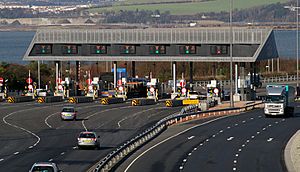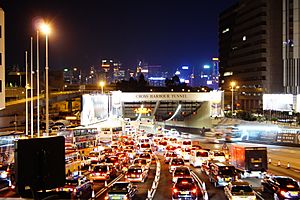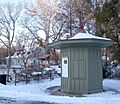Toll road facts for kids
A toll road (also known as a turnpike or toll highway) is a road where drivers pay a small fee to use it. This fee is called a "toll". Toll roads help manage how many vehicles use a certain route. They can also help people travel faster and avoid traffic congestion, making journeys quicker.
In the past, tolls were collected to provide income for governments or landowners. Today, tolls are like a special tax that helps pay for building and maintaining the road. This way, only the people who use the road help pay for it.
Contents
How Toll Roads Work
There are different kinds of toll roads. You might pay a toll to use a bridge, a tunnel, or a highway. Sometimes, the amount you pay depends on how far you travel on the road. It can also depend on the type of vehicle you are driving, like a car, motorcycle, bus, or truck. On other toll roads, everyone pays the same amount, no matter how far they go or what they drive.
There are also different ways to collect tolls. On older toll roads, you had to stop at a booth and pay a person, called a "collector." You might pay when you enter the road, when you leave, or both. These areas, called "toll plazas," can get very busy because many vehicles might be waiting to pay.

More recently, many roads use "electronic toll collection." This system uses computer chips and RFID technology. It can identify drivers and charge the toll directly to their bank accounts. This means you don't have to stop, which makes traffic flow much smoother.
Some roads have special lanes called "high occupancy toll lanes" (HOT lanes). You might have to pay to use these lanes, but vehicles with more than one person often don't have to pay. These lanes encourage carpooling, which means more people share a ride. When fewer cars are on the road, traffic is lighter, and everyone can get to their destination faster.
All roads need money to be built and kept in good condition. Roads are never truly "free." Usually, the money for building roads comes from taxes on gasoline, diesel, or other fuel. People who use toll roads pay these fuel taxes and the extra toll fee for using that specific road or lane.
History of Toll Roads
Ancient Tolls
Toll roads are very old, going back at least 2,700 years! One of the earliest known toll roads was the Susa–Babylon highway in the seventh century BC. Travelers had to pay a fee to use it.
Ancient writers like Aristotle and Pliny wrote about tolls in Arabia and other parts of Asia. In India, before the 4th century BC, a book called the Arthashastra mentioned the use of tolls. Even Germanic tribes collected tolls from travelers crossing mountain passes.
Tolls in Mythology
Tolls even appear in old stories! In Greek mythology, there was a ferryman named Charon. He charged a toll to carry the souls of the dead across the rivers Acheron and Styx to Hades, the underworld. If a soul paid the toll, Charon would ferry them across. If not, they would wander forever between life and death.
Turnpikes in the United Kingdom
In England and Wales, starting around 1706, people wanted better roads. So, "Turnpike trusts" were created. These trusts were groups given permission by Parliament to collect tolls on roads in Great Britain. They used the money to improve and maintain the roads.
At their busiest in the 1830s, there were over 1,000 trusts. They managed about 30,000 miles (48,000 km) of turnpike roads and had almost 8,000 toll-gates. These trusts helped move farm products and factory goods around, which kept prices low. The Turnpike trusts slowly ended starting in the 1870s. Most of them improved existing roads, but some new, shorter roads were also built. A famous example is Thomas Telford's Holyhead road (now the A5 road), a long new road built in the early 1800s with many toll booths.
Images for kids
-
19th-century toll booth in Brooklyn, New York
-
Balintawak toll plaza of the North Luzon Expressway in Caloocan, Philippines. The toll barrier has both electronic toll collection and cash payment in the same barrier, before a new toll plaza was added.
-
The open road tolling lanes at the West 163rd Street toll plaza, on the Tri-State Tollway near Markham, Illinois, United States
-
Overhead cameras and reader attached to a gantry on Highway 407 in Ontario
-
E-ZPass lanes at a New Jersey Turnpike (I-95) Toll Gate for Exit 8A in Monroe Township, New Jersey, United States
See also
 In Spanish: Autopista de peaje para niños
In Spanish: Autopista de peaje para niños










